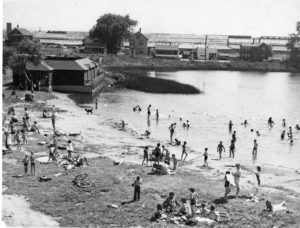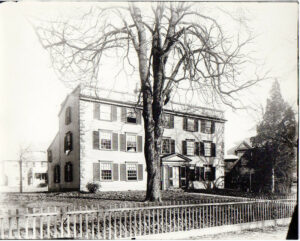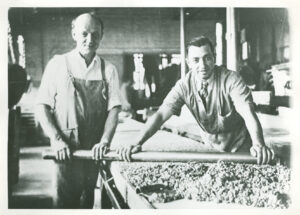The Downside of Progress
By Doug Brown, 2017
Cambridge has made a lot of things over the centuries, not all of them valuable. Our manufacturing history has its dirty, dangerous downside, and dealing with the hazards and by-products of production has always been a challenge in this jam-packed, 7.1-square-mile city.

Dump, now the site of the
50-acre Mayor Thomas W.
Danehy Park. The former
landfill was closed to
dumping in the early 1970s
and reclaimed by the city
as a community resource.
Cambridge Historical
Commission
By the end of the 19th century, the technological advances of the Second Industrial Revolution were a wonder to behold, but workers would have been less enthusiastic in their praise of conditions. Industrial accidents were a fact of life: A simple slip of the hand might mean the loss of a finger, or more, in one of the city’s many furniture factories, while chemical spills, fires, and explosions could do graver damage to an entire neighborhood. Even clandestine operations turned deadly: The Cambridge Chronicle of July 1, 1922, reported that “the explosion of an illegal 160-gallon moonshiner’s still…the largest ever unearthed in this city…started a blaze which completely destroyed the plant, caused the death of two persons, and injured several others.” New means of transportation brought new dangers too, as speeding automobiles struck down pedestrians, and electric trolleys clanked down the middle of streets. Speaking of the many new railroads and their dangers, the Cambridge-based poet and critic James Russell Lowell said, “…at least [horses] can’t blow up.”
Like their Gilded Age industrialist contemporaries, many Cantabrigians had a reason for “developing” the city: making money. Whether they were digging it up, filling it in, dumping, draining, seizing, dividing, or building on it, people profited, and the land suffered the consequences. By 1890, Cambridge was fully industrialized, and garbage was big business. Collection duties were handled by the Streets Department, staffed by teams of paupers from the North Cambridge poor farm. Combustibles were trucked to an incinerator on Main Street, where metal and glass were separated out for reuse. Ash and cinders picked up curbside went to landfill operations, a practice so widespread that today 34 percent of Cambridge sits on filled wetlands, and the primary underlying soil type for most of the city is “urban fill.” In the 1930s, a new incinerator on Bolton Street in North Cambridge reduced the overall amount of trash to be handled, but not its impact on air, soil, and water. When the incinerator couldn’t keep up, the city returned to burying and burning its refuse in open pits.
In Alan Emmet’s Cambridge, Massachusetts: The Changing of a Landscape, the author describes many of the public health issues. Water pollution was widespread: By the 1870s, the Charles River had become a smelly “waste area,” and Pout Pond in the Highlands was a “dangerous hazard.” In 1900, malaria, cholera, and dysentery were still very much a problem, and the remaining wetlands of West Cambridge were “a stench in the nostril,” [Cambridge Chronicle, 31 July 1909] polluted with slaughterhouse waste and overrun with mosquitos. Abandoned clay yards threatened public safety; children frequently drowned in unfenced pits. Prior to the turn of the century, a Joint Special Committee on Clay Lands was formed to investigate the matter. Not surprisingly, it recommended new land purchases and continued filling. Today Jerry’s Pit, Blair Pond, and Yates Pond are reminders of this former landscape.
Much of these efforts were paid for with city money, and the results were undoubtedly beneficial. Urban fill helped form Memorial Drive, Greenough Boulevard, and the modern shoreline of Fresh Pond; provided a home for Rindge Towers; and created a spot for the Armory and the Tobin School on the former site of swampy Muskrat Pond. It also remade Mill Pond, a former tidal pool turned city dump and ash heap, into Hoyt Field. Sacramento Field, filled by Harvard in the 1920s, was previously a reservoir for a bleachery next door. Raymond Park, Danehy Park, and the Cambridgeside Galleria — all were erected on filled land, as were public housing projects at Corcoran Park, Briston Arms, Walden Square, and Jefferson Park.
Sadly, hidden pollution often went hand-in-hand with urban fill. Besides ash and cinders, bricks, cars, refrigerators, tires, and even industrial waste were buried. Lead and other heavy metals, PCBs, asbestos, fossil fuel by-products, and dry cleaning fluid are common Cambridge soil pollutants. A recent test of a local property revealed lead levels of 100,000 parts per million, 500 times the legal limit. When industrial accidents, gas station spills, and soil contamination from historical auto emissions are added, the state counts more than 1,000 cases of soil or groundwater contamination within the city.
Stringent environmental rules may add costs for those who develop Cambridge land today, but that hasn’t slowed them down. West of Alewife Parkway alone, more than 3,900 new housing units have gone up since 2004, and another 1,000 are currently planned. As the city moves away from a dirtier time, building safely on the remains of that past is today’s challenge.







